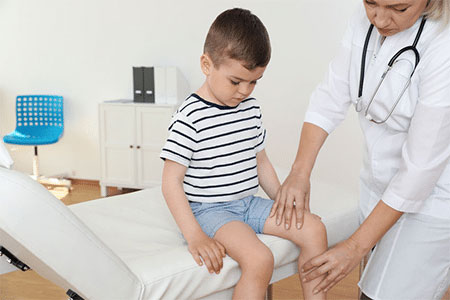The Best Shoes for Kids with Osgood-Schlatter Disease – What a Difference these Shoes Make!

Has your child been diagnosed with Osgood-Schlatter disease (OSD) and wakes up in the middle of the night complaining about knee pain?? This condition involves the swelling and irritation of the growth plate at the top of the shinbone and it usually happens in kids that are between the ages of 9 to 14 years old. I am not a medical professional, but I know which are the best shoes for kids with OSD since I have been working closely with many physical and occupational therapists who need help fitting these children in supportive shoes.
What is Osgood-Schlatter Disease?
OSD is an overuse injury –it happens when a child does the same movements over and over again– it presents as a painful bump just below the child’s knees.
Did you know that taller children and children with flat feet are at greater risk of developing Osgood-Schlatter Disease? When children have flat feet, their feet tend to collapse inwards which shifts their whole body out of alignment. This pulls the knees inwards and causes an unnecessary pull on the patella tendon – which is what connects the kneecap to the shinbone.

There are certain steps that you can take to significantly reduce or fully eliminate your child’s knee pain. The most effective ones that I have seen are wearing a pair of supportive shoes and orthotics. I actually recommend parents to start by trying a pair of supportive shoes and if the pain doesn’t reduce then I recommend investing in a pair of orthotics.
Don’t Take the “Wait and See Approach” – Be Proactive!
When children complain about foot, knee, or leg pain, pediatricians seem to always assume that they are just “growing pains” that will eventually go away. I always recommend parents to be proactive and don’t take the “wait and see approach” when it comes to treating their kids’ foot conditions, as waiting for the issue to resolve on its own can lead to the condition getting worse.

The correct type of shoes allows children to perform their normal activities, including sports, as long as they are fitted properly and provide the correct amount of support. You won’t believe what a difference the correct pair of shoes can make in helping treat this condition. This is the reason why I believe that telling children to rest and wait for the condition to go away on its own is simply poor advice.
The 4 Most Common Symptoms of Osgood-Schlatter Disease
- Your child’s knee pain increases with sports or activity.
- Your child wakes up at night complaining about knee pain.
- Swelling and/or tenderness along the top of the shinbone at the growth plate.
- A bony bump at the top of the shinbone.
Wearing supportive shoes might allow children to keep doing their everyday activities, which is going to help them maintain strength in the quadriceps and hamstring muscles, which is an important part of the recovery.
Key Shoe Features for Osgood-Schlatter Disease
1️⃣ Substantial Outsoles: This feature helps reduce the impact that your kids’ feet take when they come in contact with the ground. Certain shoes provide extra padding and targeted support to certain areas of the foot. Always look for shoes that come with a thick and supportive outsole. Below you can see the difference between a shoe with a substantial sole versus a shoe with a sole that is too thin and doesn’t provide the correct amount of support:

2️⃣ Firm Heel Counters: The heel counter is the part of the shoe that provides ankle support, and the firmer it is, the better. If you are not sure where the heel counter of the shoe is located, please take a look at the picture below for clarification:

Shoes that come with a firm heel counter are going to minimize the impact that your child’s heels take every time they come in contact with the ground. Always press on the heel counter of your kids’ shoes before buying them to ensure that it feels firm and not soft.
Below you can find the difference between a shoe with a soft heel counter and one with a firm heel counter:

Without further ado, let’s take a look at the best shoes for kids with Osgood-Schlatter Disease. Disclosure: Some links in this post may be affiliate links and we may receive a small commission (at no extra cost to you) when you click our links and make purchases.
Best Shoes for Kids with Osgood-Schlatter Disease to Prevent Pain
The shoes below are available in different widths such as medium (M), wide (W), and extra wide (XW), so make sure that you choose the width that will work best for your child’s foot shape.
Are Any Other Shoe Choices Available?
If your child has a “complicated” foot shape or you are unsure about which specific shoe might work best for your child’s feet, please do not hesitate to contact me via email or through the comments section at the end of the article: fittingchildrensshoes@gmail.com
How to Retrieve Your Child’s Exact Foot Length and Shape
I created a virtual shoe fitting service that will help you retrieve your child’s shoe size from home. It’s important that your child wears the shoes in the correct size to allow him or her to get the full support and stability that the shoes have to offer.
Sport Shoes for Kids with OSD
The impact on the knee from playing sports can aggravate OSD. Well-fitting, properly cushioned sport shoes that absorb impact are really effective in helping treat this condition. Always make sure that your child stretches properly before starting any sort of physical activity.
If your child is involved in a particular sport and needs extra support from the cleats or sport shoes I recommend that you take a look at a different article I wrote where I describe the best sport shoes for children. In that article, you will find a selection of the best sport shoes for kids in terms of support and fit.
Orthotics for Kids – Let’s Support Your Child’s Knees!
If after trying the shoes that I recommend for 2 months your child’s knee pain persists, then I recommend fitting an orthotic inside your kids’ shoes for extra support. An orthotic is a shoe insert that is designed to provide cushioning, support, and stability, and to relieve pressure areas of the foot.
The correct type of orthotics is going to align your child’s feet and improve your child’s overall posture. This will prevent the knees from turning inwards and prevent unnecessary pull on the patella tendon.
How Long Can Osgood-Schlatter Disease Last?
This condition usually goes away when the bones stop growing, and this is when the child is between 14 and 18 years old. OSD is self-recovering – it will go away completely when the two parts of bony growth join together. There are no known long-term complications associated with Osgood Schlatters disease.
There are cases of OSD in which the child needs to take one or two days of rest to deal with the pain. This condition can be very painful and limit the child’s sporting activity while they are waiting for it to go away, in some instances making them feel like “throwing in the towel”. I know this because I have helped several families who came to the shoe store with children who were ready to quit playing their favorite sports.
Have you found a particular shoe style that has worked well in reducing or fully eliminating your child’s knee pain? Please share your findings below so other families can benefit from your experiences.


Not sure I’ll do justice to expressing our family’s gratefulness for this immensely helpful information (but I’ll try! Lol). Our 7th grade son turned 12 this week, has a ridiculously-high level of intense athletic activity on a daily and weekly basis, has grown faster than a supermassive black-hole quasar in the last 18 months, aaaaaand… was diagnosed with OSD this morning (which is exactly what we expected once he began complaining of knee pain recently, then essentially diagnosed himself a few days ago).
I knew with unwavering certainty that his athletic and day-to-day footwear will play critical roles in how effectively we manage his OSD symptoms moving forward, and this article provides us with nearly everything we’re looking for (and more!).
Since his foot size is [now officially] well into grown men’s sizes – Men’s size 7½-8 (I wear a Women’s solid size 7, and he can’t even squeeze his feet into my tennis shoes anymore!). Is it safe to assume that all the same guidance and features in children’s
shoes that you mentioned in this article are what we should look for in men’s shoes moving forward? Maybe even some of the same shoe brands?
Hello Krysten,
I am happy to hear that you find the website informative!
You are correct, the same features listed in this article (substantial outsoles and firm heel counters) are the ones you should be looking into in men’s shoe styles. The shoes should also be lightweight and flexible at the same time. More importantly, the shoes should fit your son’s foot shape (narrow, medium, wide, extra wide), for your son to get the full benefits that the shoes have to offer.
I don’t suggest assuming that all shoes from a specific shoe brand will work for your son’s feet. There are only specific shoe styles among each shoe brand that provide substantial outsoles and firm heel counters, while being lightweight and flexible at the same time.
If you are unsure of your son’s foot shape, you can use this free resource: How to Measure Your Kids’ Foot – 2 Simple Steps to Determine Foot Length and Foot Width